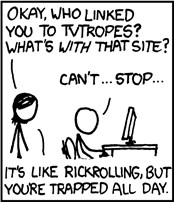In this post I will be using TV Tropes as a case study of the benefits and drawbacks of hypertext.

“Nelson first published the term ‘‘hypertext’’ in his 1965 paper, ‘‘A File Structure for the Complex, the Changing and the Indeterminate,’’ where he describes a type of computer-supported writing system that would allow for branching, linking, and responding text. It would be composed of either ‘‘written or pictorial material’’ and its defining feature is that the information would be ‘‘interconnected in such a complex
way that it could not be conveniently presented or represented on paper’’ (Nelson 1965: 96).” writes Belinda Barnet and Darren Tofts. As a novelist I have mixed feelings about hypertext.
On one hand, being able to connect ideas and follow various trains of thought is very useful especially when it comes to research. It mirrors the way the human brain works, with interconnected branches and nodes that make up a complex thought process. It’s a natural extension of the way humans think. As Christian Vandendorpe says, “Hypertext introduces a new metaphor for the representation of text, since it is conceptualized as a hierarchy or an arborescence of textual nodes linked together. The text is thus apt to be thought of as a purely logical structure.”
TV Tropes is a solid example of this use of hypertext. It is a wiki that keeps track of various tropes in media (not just television). On a given trope page, there are links to various stories, franchises, etc. that contain or subvert the trope. On a given page dedicated to a specific show, game, etc., there are links to various tropes that the media contains. There are also external links to articles, fanfiction, and other content related to the specific topic. Thus, if one wants to understand a specific fandom, a good way to do so is to go to TV Tropes. I’ve used it in this way in a media analysis project to gain a basic understanding of the fandom and development history of a video game.
However, TV Tropes also has a reputation for being a huge time sink. People have been known to spend hours following hypertext links down increasingly divergent paths, ending up in a completely different place from where they started. Hypertext reading is inherently time consuming, and it’s hard to know when to stop once one has started. Humans are not purely logical creatures and there is some merit to staying focused on one self-contained idea at times, such as when one is immersed in a fictional story. Hypertext is a great tool for participating in the greater conversation of the Internet as a whole, but it can be used incorrectly and unnecessarily like any other tool.
Word count: 450
Works cited: